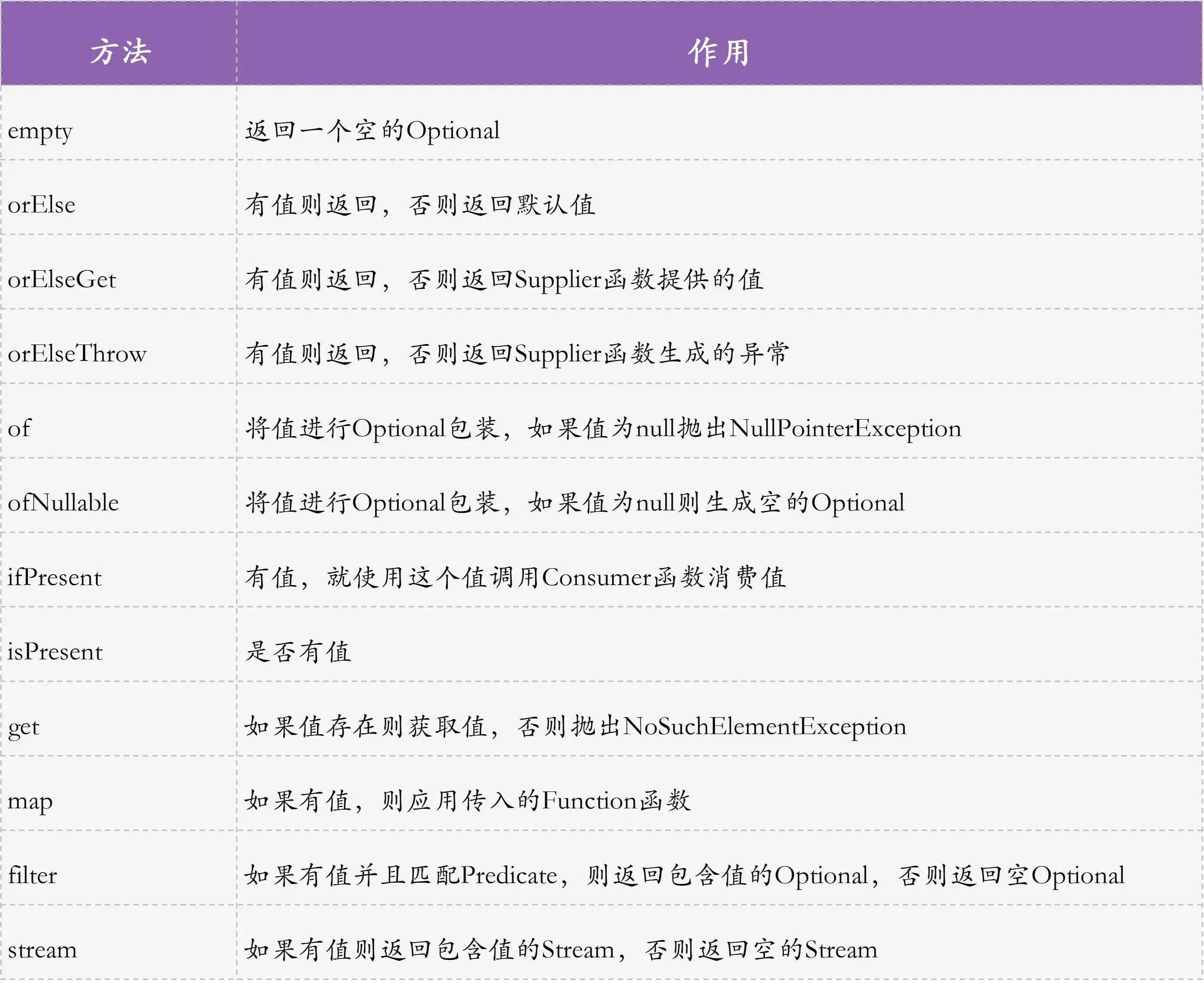Java8新特性的使用(一)
Lambda表达式
Lambda 表达式使用函数式接口匹配Java的类型系统
//匿名类 new Thread(new Runnable(){ @Override public void run(){ System.out.println("hello1"); } }).start(); //Lambda表达式 new Thread(() -> System.out.println("hello2")).start();
函数式接口及其用法
//Predicate接口是输入一个参数,返回布尔值。我们通过and方法组合两个Predicate条件,判断是否值大于0并且是偶数 Predicate<Integer> positiveNumber = i -> i > 0; Predicate<Integer> evenNumber = i -> i % 2 == 0; assertTrue(positiveNumber.and(evenNumber).test(2)); //Consumer接口是消费一个数据。我们通过andThen方法组合调用两个Consumer,输出两行abcdefg Consumer<String> println = System.out::println; println.andThen(println).accept("abcdefg"); //Function接口是输入一个数据,计算后输出一个数据。我们先把字符串转换为大写,然后通过andThen组合另一个Function实现字符串拼接 Function<String, String> upperCase = String::toUpperCase; Function<String, String> duplicate = s -> s.concat(s); assertThat(upperCase.andThen(duplicate).apply("test"), is("TESTTEST")); //Supplier是提供一个数据的接口。这里我们实现获取一个随机数 Supplier<Integer> random = ()->ThreadLocalRandom.current().nextInt(); System.out.println(random.get()); //BinaryOperator是输入两个同类型参数,输出一个同类型参数的接口。这里我们通过方法引用获得一个整数加法操作,通过Lambda表达式定义一个减法操作,然后依次调用 BinaryOperator<Integer> add = Integer::sum; BinaryOperator<Integer> subtraction = (a, b) -> a - b; assertThat(subtraction.apply(add.apply(1, 2), 3), is(0));
Predicate、Function 等函数式接口,还使用 default 关键字实现了几个默认方法。这样一来,它们既可以满足函数式接口只有一个抽象方法,又能为接口提供额外的功能:
@FunctionalInterface public interface Function<T, R> { R apply(T t); default <V> Function<V, R> compose(Function<? super V, ? extends T> before) { Objects.requireNonNull(before); return (V v) -> apply(before.apply(v)); } default <V> Function<T, V> andThen(Function<? super R, ? extends V> after) { Objects.requireNonNull(after); return (T t) -> after.apply(apply(t)); } }
使用 Java 8 简化代码
使用 Stream 简化集合操作;
用例:
//把整数列表转换为 Point2D 列表; //遍历 Point2D 列表过滤出 Y 轴 >1 的对象; //计算 Point2D 点到原点的距离; //累加所有计算出的距离,并计算距离的平均值。 private static double calc(List<Integer> ints) { //临时中间集合 List<Point2D> point2DList = new ArrayList<>(); for (Integer i : ints) { point2DList.add(new Point2D.Double((double) i % 3, (double) i / 3)); } //临时变量,纯粹是为了获得最后结果需要的中间变量 double total = 0; int count = 0; for (Point2D point2D : point2DList) { //过滤 if (point2D.getY() > 1) { //算距离 double distance = point2D.distance(0, 0); total += distance; count++; } } //注意count可能为0的可能 return count >0 ? total / count : 0; }
Java8简化
//map 方法传入的是一个 Function,可以实现对象转换; //filter 方法传入一个 Predicate,实现对象的布尔判断,只保留返回 true 的数据; //mapToDouble 用于把对象转换为 double; //通过 average 方法返回一个 OptionalDouble,代表可能包含值也可能不包含值的可空 double。 List<Integer> ints = Arrays.asList(1, 2, 3, 4, 5, 6, 7, 8); double average = calc(ints); double streamResult = ints.stream() .map(i -> new Point2D.Double((double) i % 3, (double) i / 3)) .filter(point -> point.getY() > 1) .mapToDouble(point -> point.distance(0, 0)) .average() .orElse(0); //如何用一行代码来实现,比较一下可读性 assertThat(average, is(streamResult));
使用 Optional 简化判空逻辑;
使用 Optional,不仅可以避免使用 Stream 进行级联调用的空指针问题,提供了一些实用的方法帮我们避免判空逻辑。以及使用它的 fluent API 简化冗长的 if-else 判空逻辑
@Test(expected = IllegalArgumentException.class) public void optional() { //通过get方法获取Optional中的实际值 assertThat(Optional.of(1).get(), is(1)); //通过ofNullable来初始化一个null,通过orElse方法实现Optional中无数据的时候返回一个默认值 assertThat(Optional.ofNullable(null).orElse("A"), is("A")); //OptionalDouble是基本类型double的Optional对象,isPresent判断有无数据 assertFalse(OptionalDouble.empty().isPresent()); //通过map方法可以对Optional对象进行级联转换,不会出现空指针,转换后还是一个Optional assertThat(Optional.of(1).map(Math::incrementExact).get(), is(2)); //通过filter实现Optional中数据的过滤,得到一个Optional,然后级联使用orElse提供默认值 assertThat(Optional.of(1).filter(integer -> integer % 2 == 0).orElse(null), is(nullValue())); //通过orElseThrow实现无数据时抛出异常 Optional.empty().orElseThrow(IllegalArgumentException::new); }

JDK8 结合 Lambda 和 Stream 对各种类的增强。
函数式功能,如通过HashMap实现一个缓存的操作,getProductAndCache方法:先判断缓存中是否有值;如果没有值,就从数据库搜索取值;最后,把数据加入缓存。
private Map<Long, Product> cache = new ConcurrentHashMap<>(); private Product getProductAndCache(Long id) { Product product = null; //Key存在,返回Value if (cache.containsKey(id)) { product = cache.get(id); } else { //不存在,则获取Value //需要遍历数据源查询获得Product for (Product p : Product.getData()) { if (p.getId().equals(id)) { product = p; break; } } //加入ConcurrentHashMap if (product != null) cache.put(id, product); } return product; } @Test public void notcoolCache() { getProductAndCache(1L); getProductAndCache(100L); System.out.println(cache); assertThat(cache.size(), is(1)); assertTrue(cache.containsKey(1L)); }
利用ConcurrentHashMap的computeIfAbsent方法,用一行代码就可以实现
private Product getProductAndCacheCool(Long id) { return cache.computeIfAbsent(id, i -> //当Key不存在的时候提供一个Function来代表根据Key获取Value的过程 Product.getData().stream() .filter(p -> p.getId().equals(i)) //过滤 .findFirst() //找第一个,得到Optional<Product> .orElse(null)); //如果找不到Product,则使用null } @Test public void coolCache() { getProductAndCacheCool(1L); getProductAndCacheCool(100L); System.out.println(cache); assertThat(cache.size(), is(1)); assertTrue(cache.containsKey(1L)); }
computeIfAbsent方法逻辑上相当于:
if (map.get(key) == null) { V newValue = mappingFunction.apply(key); if (newValue != null) map.put(key, newValue); }
利用 Files.walk 返回一个 Path 的流,通过两行代码就能实现递归搜索 +grep 的操作。整个逻辑是:递归搜索文件夹,查找所有的.java 文件;然后读取文件每一行内容,用正则表达式匹配 public class 关键字;最后输出文件名和这行内容。
@Test public void filesExample() throws IOException { //无限深度,递归遍历文件夹 try (Stream<Path> pathStream = Files.walk(Paths.get("."))) { pathStream.filter(Files::isRegularFile) //只查普通文件 .filter(FileSystems.getDefault().getPathMatcher("glob:**/*.java")::matches) //搜索java源码文件 .flatMap(ThrowingFunction.unchecked(path -> Files.readAllLines(path).stream() //读取文件内容,转换为Stream<List> .filter(line -> Pattern.compile("public class").matcher(line).find()) //使用正则过滤带有public class的行 .map(line -> path.getFileName() + " >> " + line))) //把这行文件内容转换为文件名+行 .forEach(System.out::println); //打印所有的行 } }
因为 Files.readAllLines 方法会抛出一个受检异常(IOException),所以使用一个自定义的函数式接口,用 ThrowingFunction 包装这个方法,把受检异常转换为运行时异常,让代码更清晰:
@FunctionalInterface public interface ThrowingFunction<T, R, E extends Throwable> { static <T, R, E extends Throwable> Function<T, R> unchecked(ThrowingFunction<T, R, E> f) { return t -> { try { return f.apply(t); } catch (Throwable e) { throw new RuntimeException(e); } }; } R apply(T t) throws E; }
并行流
Stream 操作都是串行 Stream,操作只是在一个线程中执行,此外 Java 8 还提供了并行流的功能:通过 parallel 方法,一键把 Stream 转换为并行操作提交到线程池处理。
//比如,如下代码通过线程池来并行消费处理 1 到 100: IntStream.rangeClosed(1,100).parallel().forEach(i->{ System.out.println(LocalDateTime.now() + " : " + i); try { Thread.sleep(1000); } catch (InterruptedException e) { } });
使用 threadCount 个线程对某个方法总计执行 taskCount 次操作的案例。用于演示并发情况下的多线程问题或多线程处理性能。除了会用到并行流,我们有时也会使用线程池或直接使用线程进行类似操作。
五种操作方式的场景
使用20个线程(threadCount)以并行方式总计执行 10000 次(taskCount)操作。因为单个任务单线程执行需要 10 毫秒(任务代码如下),也就是每秒吞吐量是 100 个操作,那 20 个线程 QPS 是 2000,执行完 10000 次操作最少耗时 5 秒。
private void increment(AtomicInteger atomicInteger) { atomicInteger.incrementAndGet(); try { TimeUnit.MILLISECONDS.sleep(10); } catch (InterruptedException e) { e.printStackTrace(); } }
方式一:使用线程。直接把任务按照线程数均匀分割,分配到不通的线程执行,使用CountDownLatch来阻塞主线程,直到所有线程都完成操作。这种方式需要自己分割任务:
private int thread(int taskCount, int threadCount) throws InterruptedException { //总操作次数计数器 AtomicInteger atomicInteger = new AtomicInteger(); //使用CountDownLatch来等待所有线程执行完成 CountDownLatch countDownLatch = new CountDownLatch(threadCount); //使用IntStream把数字直接转为Thread IntStream.rangeClosed(1, threadCount).mapToObj(i -> new Thread(() -> { //手动把taskCount分成taskCount份,每一份有一个线程执行 IntStream.rangeClosed(1, taskCount / threadCount).forEach(j -> increment(atomicInteger)); //每一个线程处理完成自己那部分数据之后,countDown一次 countDownLatch.countDown(); })).forEach(Thread::start); //等到所有线程执行完成 countDownLatch.await(); //查询计数器当前值 return atomicInteger.get(); }
方式二:使用Executors.newFixedThreadPool来获得固定线程数的线程池,使用execute提交所有任务到线程池执行,最后关闭线程池等待所有任务执行完成:
private int threadpool(int taskCount, int threadCount) throws InterruptedException { //总操作次数计数器 AtomicInteger atomicInteger = new AtomicInteger(); //初始化一个线程数量=threadCount的线程池 ExecutorService executorService = Executors.newFixedThreadPool(threadCount); //所有任务直接提交到线程池处理 IntStream.rangeClosed(1, taskCount).forEach(i -> executorService.execute(() -> increment(atomicInteger))); //提交关闭线程池申请,等待之前所有任务执行完成 executorService.shutdown(); executorService.awaitTermination(1, TimeUnit.HOURS); //查询计数器当前值 return atomicInteger.get(); }
方式三:使用ForkJoinPool而不是普通线程池执行任务
ForkJoinPool 和传统的 ThreadPoolExecutor 区别在于,前者对于 n 并行度有 n 个独立队列,后者是共享队列。如果有大量执行耗时比较短的任务,ThreadPoolExecutor 的单队列就可能会成为瓶颈。这时,使用 ForkJoinPool 性能会更好。
因此,ForkJoinPool 更适合大任务分割成许多小任务并行执行的场景,而 ThreadPoolExecutor 适合许多独立任务并发执行的场景。
private int forkjoin(int taskCount, int threadCount) throws InterruptedException { //总操作次数计数器 AtomicInteger atomicInteger = new AtomicInteger(); //自定义一个并行度=threadCount的ForkJoinPool ForkJoinPool forkJoinPool = new ForkJoinPool(threadCount); //所有任务直接提交到线程池处理 forkJoinPool.execute(() -> IntStream.rangeClosed(1, taskCount).parallel().forEach(i -> increment(atomicInteger))); //提交关闭线程池申请,等待之前所有任务执行完成 forkJoinPool.shutdown(); forkJoinPool.awaitTermination(1, TimeUnit.HOURS); //查询计数器当前值 return atomicInteger.get(); }
方式四:直接使用并行流,并行流使用公共的ForkJoinPool,也就是ForkJoinPool.commonPool()
公共的 ForkJoinPool 默认的并行度是 CPU 核心数 -1,原因是对于 CPU 绑定的任务分配超过 CPU 个数的线程没有意义。由于并行流还会使用主线程执行任务,也会占用一个 CPU 核心,所以公共 ForkJoinPool 的并行度即使 -1 也能用满所有 CPU 核心。
//通过配置强制指定(增大)了并行数,但因为使用的是公共 ForkJoinPool,所以可能会存在干扰,线程池混用产生的问题
private int stream(int taskCount, int threadCount) { //设置公共ForkJoinPool的并行度 System.setProperty("java.util.concurrent.ForkJoinPool.common.parallelism", String.valueOf(threadCount)); //总操作次数计数器 AtomicInteger atomicInteger = new AtomicInteger(); //由于我们设置了公共ForkJoinPool的并行度,直接使用parallel提交任务即可 IntStream.rangeClosed(1, taskCount).parallel().forEach(i -> increment(atomicInteger)); //查询计数器当前值 return atomicInteger.get(); }
方式五:使用CompletableFuture来实现。CompletableFuture.runAsync方法指定一个线程池,一般会在使用CompletableFuture的时候用到:
private int completableFuture(int taskCount, int threadCount) throws InterruptedException, ExecutionException { //总操作次数计数器 AtomicInteger atomicInteger = new AtomicInteger(); //自定义一个并行度=threadCount的ForkJoinPool ForkJoinPool forkJoinPool = new ForkJoinPool(threadCount); //使用CompletableFuture.runAsync通过指定线程池异步执行任务 CompletableFuture.runAsync(() -> IntStream.rangeClosed(1, taskCount).parallel().forEach(i -> increment(atomicInteger)), forkJoinPool).get(); //查询计数器当前值 return atomicInteger.get(); }
一般而言,使用线程池(第二种)和直接使用并行流(第四种)的方式在业务代码中比较常用。另外例子中一定是先运行 stream 方法再运行 forkjoin 方法,对公共 ForkJoinPool 默认并行度的修改才能生效。
这是因为 ForkJoinPool 类初始化公共线程池是在静态代码块里,加载类时就会进行的,如果 forkjoin 方法中先使用了 ForkJoinPool,即便 stream 方法中设置了系统属性也不会起作用。因此建议是,设置 ForkJoinPool 公共线程池默认并行度的操作,应该放在应用启动时设置。
原文链接:https://time.geekbang.org/column/intro/100047701



 浙公网安备 33010602011771号
浙公网安备 33010602011771号